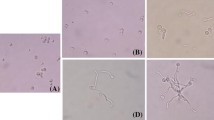Abstract
New catecholamine ruthenium(III) complexes with potentially interesting biological activity are described. The complexes were prepared by reacting catecholamine with [RuCl(NH3)5]Cl2. The newly prepared species were formulated as [RuIII(NH3)4(catecholamine-R)]n+ where catecholamine-R = noradrenaline, dopamine and isoproterenol, and were characterized by elemental analysis, e.p.r., electronic absorption and f.t.-i.r. They were moderately stable in water at room temperature for at least 1 week. In vitro tests of antifungal activity showed the ruthenium–catecholamine complexes had strong inhibitory action against the pathogenic yeast Candida albicans, Candida glabrata and Candida tropicalis. Free catecholamine does not show any antifungal activity.
Similar content being viewed by others
References
P.J. Sadler and Z. Gun, Pure Appl. Chem., 70, 863 (1998).
P.J. Sadler, Adv. Inorg. Chem., 36, 1 (1991).
M.J. Abrams and B.A. Murrer, Science,261, 725 (1993).
B.R. Cameron and I.R. Baird, J. Inorg. Biochem., 83, 233 (2001).
(a)C. Dendrinou-Samara, G. Tsotsou, L.V. Ekateriniadou, A.H. Kortsaris, C.P. Raptopoulou, A. Tersis, D.A. Kyriakidis and D.P. Kessissoglou, J. Inorg. Biochem., 71, 171 (1998);(b) G. Mokdsi and M.M. Harding, J. Inorg. Biochem., 86, 611 (2001); (c) A. Topacli and B. Kesimli, Spectrosc. Lett., 34 513 (2001);(d) N. Margiotta, F.P. Fanizzi, J. Kobe and G. Natile, Eur. J. Inorg. Chem., 47, 213 (2000);(e) K. Sakai, Y. Tomita, T. Eu, K. Goshima, M. Ohminato, T. Tsubomura, K. Matsumoto, K. Ohmura and K. Kawakami, Inorg. Chim. Acta, 297, 64 (2000); (f) C.A. Allardyce and P.J. Dyson, Platinum Met., 45, 62 (2001).
(a)O. Clement, I. Onyido and E. Buncel, Can. J. Chem., 78, 474 (2000);(b) M.N.V. Prasad, Analusis, 26, 25 (1998);(c) L. Rivas, A. Murza, S. Sanches-Cortes and J.V. Garcia-Ramos, J. Biomol. Struct Dyn., 18, 371 (2000);(d) R. Bakhtiar and E.I. Ochiai, Gen. Pharmacol., 32, 525 (1999).
C.W. Schwitert and J.P. McCue, Coord. Chem. Rev., 184, 67 (1999).
G. Stochel, A. Wanat, E. Kulis and Z. Stasicka, Coord. Chem. Rev., 171, 203 (1998).
Z. Guo and P.J. Sadler, Adv. Inorg. Chem., 49, 183 (2000).
R.S. da Silva, E. Tfouni and A.B.P. Lever, Inorg. Chim. Acta, 235, 427 (1995).
M. Haga, E.S. Dodsworth and A.B.P. Lever, Inorg. Chem., 25, 447 (1986).
C.J. Cunha, S.S. Fielder, D.V. Stynes, H. Masui and P.R. Auburn and A.B.P. Lever, Inorg. Chim. Acta, 242, 293 (1996).
A. DelMedico, W.J. Pietro and A.B.P. Lever, Inorg. Chim. Acta, 281, 126 (1998).
_A.B.P. Lever and S.I. Gorelsky, Coord. Chem. Rev., 208, 153 (2000).
R.S. da Silva, S.I. Gorelsky, E.S. Dodsworth, E. Tfoun and A.B.P. Lever, J. Chem. Soc., Dalton Trans., 4078 (2000).
A.D. Allen and F. Bottomley, Can. J. Chem., 46, 469 (1968).
F.N. Rein, R.C. Rocha and H.E. Toma, J. Electroanal. Chem., 494, 21 (2000).
F.N. Rein, R.C. Rocha and H.E. Toma, Inorg. Chem., 85, 155 (2001).
J. Smythies, Behav. Brain Res., 99, 1 (1999).
A. Rojo, A. Fontan, M.A. Mena, A. Herranz, S. Casado and J.G. Yebenes, Parkinsonism Relat. Disord., 7, 93 (2001).
V.P. Chekhonin, V.P. Baklaushev, B.M. Kogan, E.A. Savchenko, S.V. Lebedev, I.V. Man'kovskaya, T.S. Filatova, I.U. Yusupova and T.B. Dmitrieva, Bull. Exp. Biol. Medic., 130, 805 (2000).
F.L. van Muiswinkel, F.M. Riemers, G.J. Peters, M.V.M. LaFleur, D. Siegel, C.A.M. Jongenelen and B. Drukarch, Free Radic. Biol. Med., 29, 442 (2000).
R.V. Fogarty and J.M. Tobin, Enzyme Microb. Technol, 19, 311 (1996).
M.J. Butler and A.W. Day, Can. J. Microbiol., 44, 1115 (1998).
N. Dharmaraj, P. Viswanathamurthi and K. Natarajan, Transition Met. Chem., 26, 105 (2001).
B. Cetinkaya, I. Ozdemir, B. Binbasioglu, R. Durmaz and S. Günal, Drug Res., 49, 538 (1999).
R. Ramesh and K. Natarajan, Synth. React. Inorg. Met. Org. Chem., 26, 1677 (1996).
H. Masui, A.B.P. Lever and P.R. Auburn, Inorg. Chem., 30, 2402 (1991).
M.E. Cass, N.R. Gordon and C.G. Pierpont, Inorg. Chem., 25, 3962 (1986).
K.D. Magers, C.G. Smith and D.T. Sawyer, Inorg. Chem., 19, 492 (1980).
P.B. Kettler, Y.D. Chang, J. Zubieta and M.J. Abrams, Inorg. Chim. Acta, 218 (1994).
N. Bag, G.K. Lahiri, P. Basu and A. Chakravorty J. Chem. Soc., Dalton Trans., 113 (1992).
C.G. Pierpont and R.M. Buchanan, Coord. Chem. Rev., 45 (1981).
Author information
Authors and Affiliations
Rights and permissions
About this article
Cite this article
de Lima, R.G., Lever, A., Ito, I.Y. et al. Antifungal activity of novel catecholamine ruthenium(III) complexes. Transition Metal Chemistry 28, 272–275 (2003). https://doi.org/10.1023/A:1022967403627
Issue Date:
DOI: https://doi.org/10.1023/A:1022967403627




